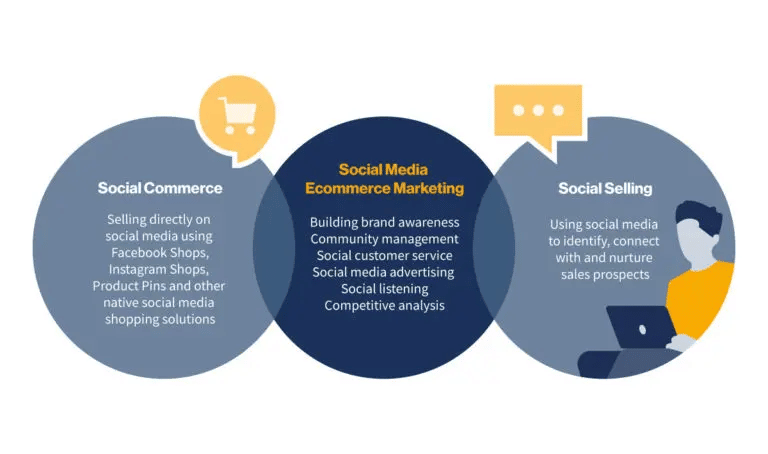Social media ecommerce marketing vs. social selling vs. social commerce
You’ve likely heard the terms social media ecommerce marketing, social selling, and social commerce. They’re often used interchangeably, but they’re not the same thing.
Let’s take a look at how they’re different.
Social media ecommerce marketing
This is when ecommerce businesses use social media as a marketing channel to promote their brand, product, or service to drive more sales and connect with customers.
Social selling
This is when brands use social media to identify, connect with, and nurture sales prospects. It’s a tactic that helps businesses reach and engage with sales targets via social media.
Think of social selling as modern relationship-building. The goal is to connect with potential customers, and offer support and guidance. Then, when that person is in buy mode, your product or service comes to mind first.
Social commerce
This is when brands sell products or services directly on social media using native solutions like Facebook Shops, Instagram Shops, Pinterest Product Pins, or TikTok Shop.
Social commerce lets customers shop, select, and complete purchases without leaving social media apps.
1. Build brand awareness
There’s no better marketing channel for generating buzz than social media. It’s the perfect place to promote your new store, products, services, events, or promotions. And it’s great for engaging in conversations with your target audience.
To successfully build brand awareness, create a consistent posting strategy with a unified voice and message. Publish on multiple channels, in multiple formats. Engage with hot topics, hashtags, and in direct conversations with users.
Building brand awareness is a process. It takes time. To help, follow these tips:
- Showcase your personality and values
- Be consistent in your messaging
- Speak to the right people
- Demonstrate your value
- Respond to feedback
Brand building example: tentree
Tentree is a clothing company that doesn’t shy away from their mission to promote sustainability. They lean into this message on social media. Take this tweet, for example, that showcases self-sustaining cabins in Finland. The post doesn’t directly promote Tentree’s products, but it’s inspiring and aesthetically pleasing, and it reinforces what the brand is all about.
2. Advertise
There’s no more powerful advertising channel out there than social media. The global ad reach on social media is massive, and growing rapidly.
Here’s the ad reach by social media channel, according to Hootsuite’s reporting:
- 2.17 billion on Facebook Ads
- 1.44 billion on Instagram Ads
- 1.02 billion on TikTok Ads
- 849.6 million on LinkedIn Ads
The audiences are huge. Too huge, in fact. Which is why these social channels also have
powerful targeting and segmentation tools.
To advertise effectively on social media, make sure you:
- Identify your target market and audience
- Layer targeting parameters to zero in on that audience
- Create a compelling content strategy to speak to them
- Define your goals and KPIs for each channel
- Pick the ad types that align with your goals
- Specify the right conversion metrics
The goals you have for social media advertising will dictate the ad types, KPIs, and conversion metrics you choose. And the platforms you invest in.
A goal to drive brand awareness, for example, is best suited to:
- Image, video and carousel ads, that drive
- Store visits, ad impressions, and engagement
If you want to drive sales, you’d want to go with:
- Product, collection, or shopping ads, that drive
- Direct purchases, product page visits
To get started, select your goal. Then define the type of ads and targeting you need. And then define how you’ll track success.
You can learn more about ad objectives and formats across different platforms in our guide to social media advertising.
Advertising example: The Bay
The Bay is a major Canadian department store that uses Instagram advertising for brand building and product sales. In the ad below, they combine their unique visual flare with shoppable catalog ads.
3. Sell products directly on social media
Social commerce has never been easier. Currently, there are four social media apps with native built-in social selling capabilities:
- TikTok
Twitter and Snapchat have also both partnered with Shopify to create social commerce tools of their own.
This is where social media ecommerce marketing overlaps with social commerce. Where the reach and brand-building power of social media can lead to direct business.
The benefits of using social commerce solutions include:
- They’re free to set up
- They create memorable, interactive online shopping experiences
- They streamline the sales process
- They extend the places in which sales can happen
- They enable headless commerce
- They give you the ability to create live shopping experiences



.png)
0 comments:
Post a Comment